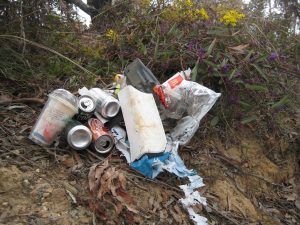Suffocating roadside rubbish
Urban dwellers often take pride in, and some degree of ownership for the nature strip or roadside verge outside their homes. Mowing grass, edging the footpath and rubbish removal are common activities undertaken by the urban community.
Rural landholders view their roadsides in much the same manner. Some even consider the roadsides close to their holdings as an extension of their driveway. The presence of litter amongst the roadside vegetation is no less distasteful to rural dwellers than it is to the urban community. The natural vegetation along our rural roadsides is both beautiful and uniquely Australian. Locals and visitors alike do not wish to see litter on the roadsides, amongst our uniquely Australian landscape.
Roadside litter may also cause injury or death to native animals which use roadside vegetation as habitat. Carelessly discarded containers can trap small mammals or reptiles. The consumption of small plastic items can suffocate any animal. Circular items such as those found on the tamper proof lids of plastic milk bottles can slowly strangle an animal as it grows.
Those driving along our rural roads need to be observant for wildlife or livestock on the roadsides, which may stray onto the road and cause an accident. Rural landholders are often more observant of roadside activity, looking also for damaged fences, escaping livestock, weeds and feral animals. This heightened observational level makes the presence of roadside litter glaringly apparent.
Sometimes rubbish may escape trailers, utes or trucks, but, on inspection, mostly this litter is a result of the disposal of fast food containers, bottles and cans once the contents are consumed. This has become a fact of life in Australia, and will continue to be so until penalties for littering are severe enough to dissuade the activity of casually tossing rubbish out of the car window. Surprisingly 94% of people surveyed identified litter as a major environmental problem!

This pile of rubbish was picked up in 5 minutes along one of our rural roads.
Despite the continued practice of littering there is a lot the community can do. Enjoy the sunshine, get some exercise and clean up our rural roadsides. Take a suitable container, walk one kilometer picking up rubbish as you go, cross the road and continue back to the starting point. Litter attracts litter. The presence of roadside litter gives the impression that the residents do not care about their environment. Therefore, if it bothers you, pick it up. There is no need to wait for Clean Up Australia Day, take action now and show pride in your local area.

